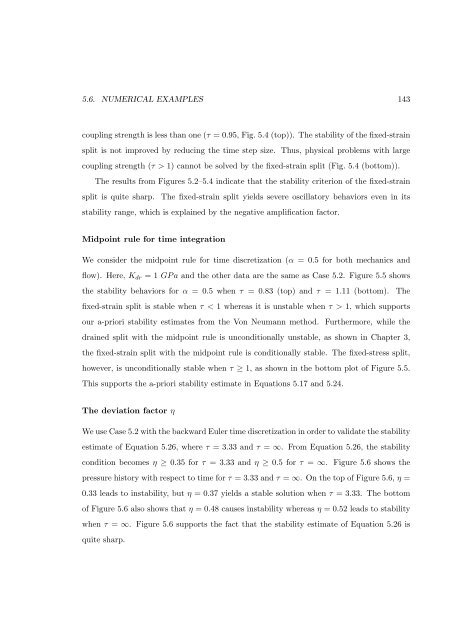Sequential Methods for Coupled Geomechanics and Multiphase Flow
Sequential Methods for Coupled Geomechanics and Multiphase Flow
Sequential Methods for Coupled Geomechanics and Multiphase Flow
Create successful ePaper yourself
Turn your PDF publications into a flip-book with our unique Google optimized e-Paper software.
5.6. NUMERICAL EXAMPLES 143<br />
coupling strength is less than one (τ = 0.95, Fig. 5.4 (top)). The stability of the fixed-strain<br />
split is not improved by reducing the time step size. Thus, physical problems with large<br />
coupling strength (τ > 1) cannot be solved by the fixed-strain split (Fig. 5.4 (bottom)).<br />
The results from Figures 5.2–5.4 indicate that the stability criterion of the fixed-strain<br />
split is quite sharp. The fixed-strain split yields severe oscillatory behaviors even in its<br />
stability range, which is explained by the negative amplification factor.<br />
Midpoint rule <strong>for</strong> time integration<br />
We consider the midpoint rule <strong>for</strong> time discretization (α = 0.5 <strong>for</strong> both mechanics <strong>and</strong><br />
flow). Here, Kdr = 1 GPa <strong>and</strong> the other data are the same as Case 5.2. Figure 5.5 shows<br />
the stability behaviors <strong>for</strong> α = 0.5 when τ = 0.83 (top) <strong>and</strong> τ = 1.11 (bottom). The<br />
fixed-strain split is stable when τ < 1 whereas it is unstable when τ > 1, which supports<br />
our a-priori stability estimates from the Von Neumann method. Furthermore, while the<br />
drained split with the midpoint rule is unconditionally unstable, as shown in Chapter 3,<br />
the fixed-strain split with the midpoint rule is conditionally stable. The fixed-stress split,<br />
however, is unconditionally stable when τ ≥ 1, as shown in the bottom plot of Figure 5.5.<br />
This supports the a-priori stability estimate in Equations 5.17 <strong>and</strong> 5.24.<br />
The deviation factor η<br />
We use Case 5.2 with the backward Euler time discretization in order to validate the stability<br />
estimate of Equation 5.26, where τ = 3.33 <strong>and</strong> τ = ∞. From Equation 5.26, the stability<br />
condition becomes η ≥ 0.35 <strong>for</strong> τ = 3.33 <strong>and</strong> η ≥ 0.5 <strong>for</strong> τ = ∞. Figure 5.6 shows the<br />
pressure history with respect to time <strong>for</strong> τ = 3.33 <strong>and</strong> τ = ∞. On the top of Figure 5.6, η =<br />
0.33 leads to instability, but η = 0.37 yields a stable solution when τ = 3.33. The bottom<br />
of Figure 5.6 also shows that η = 0.48 causes instability whereas η = 0.52 leads to stability<br />
when τ = ∞. Figure 5.6 supports the fact that the stability estimate of Equation 5.26 is<br />
quite sharp.
















